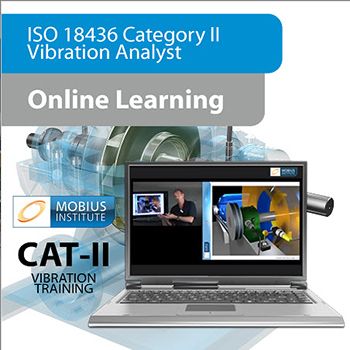ISO Category II Vibration Analyst - Intermediate
This course is intended for people who have mastered the basics but who need to be able to take good data (and decide how the data collector should be set up), analyze a range of fault conditions, and understand balancing and alignment.
We teach you to test machines correctly, how to diagnose faults accurately, perform additional diagnostic tests for verification, how to set vibration alarm limits, and how to correct certain types of faults. You will learn what your analyzer settings mean so that you can take the best measurements. And you will learn why the vibration signatures change the way they do and how to use time waveform analysis and phase analysis to verify the fault condition.
You will come away from the course with a solid understanding of:
- How a well-designed program and a reliability centered maintenance approach improve the OEE and therefore the bottom line
- The condition monitoring technologies: acoustic emission, infrared analysis (thermography), oil analysis, wear particle analysis, & motor testing via supplementary training
- How machines work; via supplementary selfstudy using the “Equipment Knowledge” section
- How to select the correct measurement location and axis, and collect good, repeatable measurements
- What the Fmax, resolution, averaging and other analyzer settings mean, and how to select the optimum settings for a wide variety of machine types
- How to analyze vibration spectra, time waveforms, envelope (demodulation), and phase measurements
- How to diagnose: unbalance, eccentricity, misalignment, bent shaft, cocked bearing, looseness, rolling element bearings faults, journal bearing faults, gearbox faults, resonance, and other conditions
- How to set alarm limits manually and with statistics
- How to balance and align a machine, and correct a resonance condition
Review of maintenance practices
Review of condition monitoring technologies
Principles of vibration
- Complete review of basics
- Waveform, spectrum (FFT), phase and orbits
- Understanding signals: modulation, beating, sum/difference
- Transducer types: Non-contact displacement proximity probes, velocity sensors, and accelerometers
- Transducer selection
- Transducer mounting and natural frequency
- Measurement point selection
- Following routes, and test planning
- Common measurement errors
- Filters: Low pass, band pass, high pass, band stop
- Sampling, aliasing, dynamic range
- Resolution, Fmax, data collection time
- Averaging: linear, overlap, peak hold, time synchronous
- Windowing and leakage
- Spectrum analysis
- Time waveform analysis (introduction)
- Orbit analysis (introduction)
- Phase analysis: bubble diagrams and ODS
- Enveloping (demodulation), shock pulse, spike energy, PeakVue
- Natural frequencies and resonances
- Imbalance, eccentricity and bent shaft
- Misalignment, cocked bearing and soft foot
- Mechanical looseness
- Rolling element bearing analysis
- Analysis of induction motors
- Analysis of gears
- Analysis of belt driven machines
- Analysis of pumps, compressors and fans
- Impact testing (bump tests)
- Phase analysis
- General maintenance repair activities
- Review of the balancing process
- Review of shaft alignment procedures
- Setting baselines
- Setting alarms: band, envelope/mask, statistical
- Setting goals and expectations (avoiding common problems)
- Report generation
- Reporting success stories
Acceptance testing
Review of ISO standards

